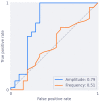Quantifiable Measures of Abdominal Wall Motion for Quality Assessment of Cine-MRI Slices in Detection of Abdominal Adhesions
- PMID: 37233312
- PMCID: PMC10219278
- DOI: 10.3390/jimaging9050092
Quantifiable Measures of Abdominal Wall Motion for Quality Assessment of Cine-MRI Slices in Detection of Abdominal Adhesions
Abstract
Abdominal adhesions present a diagnostic challenge, and classic imaging modalities can miss their presence. Cine-MRI, which records visceral sliding during patient-controlled breathing, has proven useful in detecting and mapping adhesions. However, patient movements can affect the accuracy of these images, despite there being no standardized algorithm for defining sufficiently high-quality images. This study aims to develop a biomarker for patient movements and determine which patient-related factors influence movement during cine-MRI. Included patients underwent cine-MRI to detect adhesions for chronic abdominal complaints, data were collected from electronic patient files and radiologic reports. Ninety slices of cine-MRI were assessed for quality, using a five-point scale to quantify amplitude, frequency, and slope, from which an image-processing algorithm was developed. The biomarkers closely correlated with qualitative assessments, with an amplitude of 6.5 mm used to distinguish between sufficient and insufficient-quality slices. In multivariable analysis, the amplitude of movement was influenced by age, sex, length, and the presence of a stoma. Unfortunately, no factor was changeable. Strategies for mitigating their impact may be challenging. This study highlights the utility of the developed biomarker in evaluating image quality and providing useful feedback for clinicians. Future studies could improve diagnostic quality by implementing automated quality criteria during cine-MRI.
Keywords: adhesions; algorithm; biomarker; cine-MRI; diagnostic quality.
Conflict of interest statement
The authors declare no conflict of interest.
Figures



References
-
- van den Beukel B.A.W., Stommel M.W.J., van Leuven S., Strik C., MA I.J., Joosten F., van Goor H., Ten Broek R.P.G. A Shared Decision Approach to Chronic Abdominal Pain Based on Cine-MRI: A Prospective Cohort Study. Am. J. Gastroenterol. 2018;113:1229–1237. doi: 10.1038/s41395-018-0158-9. - DOI - PubMed
-
- Stommel M.W.J., Ten Broek R.P.G., Strik C., Slooter G.D., Verhoef C., Grünhagen D.J., van Duijvendijk P., Bemelmans M.H.A., den Dulk M., Sietses C., et al. Multicenter Observational Study of Adhesion Formation After Open-and Laparoscopic Surgery for Colorectal Cancer. Ann. Surg. 2018;267:743–748. doi: 10.1097/SLA.0000000000002175. - DOI - PubMed
LinkOut - more resources
Full Text Sources

